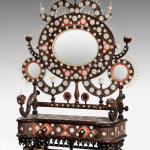Anglo-Indian Ivory Mounted and Incised Lacquer Dressing Mirror
122 x 76.5 x 42 cm
Further images
-
(View a larger image of thumbnail 1
)

-
(View a larger image of thumbnail 2
)

-
(View a larger image of thumbnail 3
)

-
(View a larger image of thumbnail 4
)

-
(View a larger image of thumbnail 5
)

-
(View a larger image of thumbnail 6
)

-
(View a larger image of thumbnail 7
)

-
(View a larger image of thumbnail 8
)

-
(View a larger image of thumbnail 9
)

-
(View a larger image of thumbnail 10
)

-
(View a larger image of thumbnail 11
)

-
(View a larger image of thumbnail 12
)

-
(View a larger image of thumbnail 13
)

-
(View a larger image of thumbnail 14
)

-
(View a larger image of thumbnail 15
)

-
(View a larger image of thumbnail 16
)

Makeshift lacquer ground incised with floral designs and Mercury rings, ivory pierced circles and a plethora of finials. With a pivoting mirror at the centre of the cabinet.
Amin Jaffer explains that this toilet glass is an: ‘unusually exuberant example of a type of furniture made in Dera Ismail Khan, a town in the Punjab (presently in Pakistan) from the second half of the nineteenth Century… The work is distinguished by a naskshi lacquered ground, incised with floral designs and inlaid with mercury rings, to which are applied serrated and pierced circles of ivory.’ (from a letter from Amin Jaffer, dated 25 March 1999).
Lacquered turnery in wood was the most prominent industry of Dera Ismail Khan: ‘The lac turnery, carried on at Dera Ismail Khan, is of considerable artistic merit, and is applied to larger articles than is usual in this class of work, the small round tables being well-known. The general tone of colour is subdued and almost sombre, red, black, and dark green, relieved by a little grey, being the principal colours, with ornaments in amalgam, which have the effect of dull silvery lines. The pattern is always inscribed with a style, and in certain parts the lines are filled with amalgam. Ivory and camel-bone ornaments in the shape of knobs, studs, and flowers are liberally employed.’ (from the ‘Imperial Gazzetter of India for the North-West Frontier Province’, 19085: 52 quoted in Fouzia Saeed, ‘Traditional Furniture of D.I. Khan’ (Lok Virsa Research Centre, Karachi, 1988), pp.7-8).
In the ‘Official Catalogue of the Indian Art Exhibition, Delhi’ of 1902-1903, George Watt describes ‘Etched Nakshi’: ‘In this class of turnery the object is coated with first one colour, then on the top a second, a third or a fourth, uniformly all over. The battis employed are for the most part soft and water-prepared. The first colour is usually yellow, the nest red, followed by green and last of all by black; but, of course, any assortment or number of colours may be imparted layer upon layer, the one on the top of the other. With a fine chisel or style the lac-coated surface is now scratched, the hand being made to move lightly or to press heavily as may be necessary to bring out the colour required from the numerous layers beneath the surface. In this way, upon a black background, yellow stems and leaf stalks, green leaves and red flowers with yellow or parti-coloured veins and shadings may be elaborated in a manner analogous to the sgraffito of the Italians.’
Watt then describes the regional variations in the lacquer work stating that: ‘In DERA ISMAIL KHAN (Plate No.44, fig.7), ivory buttons or discs are given as centres for an elaborate and minute floral design.’ (George Watt, ‘Official Catalogue of the Indian Art Exhibition, Delhi’, 1903, pp.214-5.).
Comparators:
The Victoria & Albert Museum possesses three round spice boxes of similar workmanship, two of which formerly belonged to the Indian Museum (which merged with the V&A in 1880) and one of which was acquired in 1883 – Museum number: IS.2377-1883; http://collections.vam.ac.uk/item/O473261/object/
















